Cypriot Food: Basic Overview
Common Ingredients
Common Cooking Methods
Courses
Meals
Key Taste
Eating Etiquette
Meal Presentation
Culinary Festivals
Influence and Fusion
Popular Types of Cypriot Food
-
Charcuterie and cheese boards
In Cyprus, the tradition of charcuterie and cheese typically feature an array of smoked, cured, and aged delicacies, alongside cheeses that range from soft and mild to hard and salty.
The inclusion of aromatic herbs and spices in the curing process adds a unique Mediterranean flair.
-
Desserts
Cypriot desserts are characterized by their sweet indulgence, often incorporating local ingredients like honey, nuts, and fresh dairy.
The confections balance textures and flavors, from syrup-soaked pastries to rich, cheese-filled delights.
These treats are not just about taste but also celebrate the island’s cultural festivities and seasons, making them an integral part of Cypriot culinary traditions.
-
Fried dishes
The fried fare in Cypriot cuisine is known for its heartiness and comfort, featuring a variety of meats, and vegetables enveloped in a golden, crispy exterior.
These dishes often incorporate a mix of local spices and herbs, adding depth and warmth to the flavors.
These fried dishes are a beloved choice for both everyday meals and celebratory occasions.
-
Soups
Cypriot soups are a testament to the island’s culinary diversity, ranging from light and tangy to rich and hearty broths.
These soups often feature a base of local grains, legumes, or meats, enriched with fresh vegetables and aromatic herbs.
The use of citrus, dairy, and eggs to thicken and flavor the soups adds a distinctive touch, making them a comforting and nourishing part of the Cypriot diet.
-
Stews
In Cypriot stews, the slow melding of flavors is paramount, with an emphasis on tender meats and vegetables simmered in rich sauces.
The stews often feature a harmonious blend of sweet and savory elements, incorporating local wine, herbs, and spices.
Cypriot dishes are culinary creations enjoyed widely in Cyprus, an island country in the Eastern Mediterranean Sea. Both Greek Cypriots and Turkish Cypriots widely love these local foods.
Owing to its geographical location, Cypriot cuisine draws influences from West Asian and Southeast European countries, notably from Greek delights and Turkish culinary treasures.
As a result, dishes in this island country mainly include meat dishes, vegetable dishes, and different mezes (appetizers) made from various ingredients, like Halloumi cheese, cured meat, cucumber, and yogurt.
Here, I’ll walk you through the primary characteristics of traditional Cypriot food, its worldwide popularity, and its health benefits.
Then, check out the list of Cypriot dishes with detailed information on their origins, main ingredients, preparation methods, varieties, and serving suggestions.
Subsequently, a comparison between Greek Cypriot and Turkish Cypriot dishes is presented to elucidate their differences. To conclude, I also draw concise comparisons between Greek and Greek Cypriot dishes.
Featured below are 23 renowned dishes of Cyprus, categorized by how popular they are:
23 Popular Cypriot Dishes with Filters
In this part, you’ll discover 23 dishes commonly enjoyed in Cyprus. And with the filter options, I hope you will optimize your reading and search for your beloved dishes based on ingredients, taste, popularity, etc.
Furthermore, below are some brief information about the five groups, including the most popular delights, national dishes, traditional, fusion recipes, and street food culture.
Cypriot cuisine is renowned for halloumi cheese, souvla, moussaka, etc. These dishes often contain local herbs, olive oil, and meats, reflecting the island’s agricultural bounty and culinary influences.
Souvla, kleftiko, and tarhana are widely recognized as iconic Cyprus’s national dishes, showing the country’s culinary pride.
Cypriot fusion cuisine combines traditional elements with international influences. An example is makaronia tou fournou dish.
Halloumi Cheese
Halloumi, or haloumi, is a traditional squeaky cheese in Cyprus, with the earliest records dating back to the mid-16th century. Originally, halloumi cheese was made with goat or sheep’s milk, but modern versions use cow’s milk since it’s cheaper.
Interestingly, since halloumi has a high melting point, it gets creamier once grilled or fried instead of melting. Therefore, you will likely see halloumi as a meat substitute for grilled dishes alongside vegetables or a component in salads, sandwiches, or meze dishes.
Halloumi has 2 main types: fresh or mature, depending on the production method. The matured halloumi is brined, hence a drier, harder texture and saltier taste. Meanwhile, fresh ones are milder and more elastic.
Despite the differences in texture and flavor, both types last for a year if sealed and refrigerated.
Souvla
- National
- Traditional
Souvla is a national Cypriot dish known for its large pieces of meat that are slow-cooked on a long skewer over a charcoal grill.
Unlike its Greek counterpart, souvlaki, which uses smaller cuts of meat, souvla features chunkier pieces that are cooked more slowly and at a greater distance from the charcoal, allowing for a tender and juicy result.
The dish is commonly made with lamb, pork, or chicken, and the meat is often seasoned with salt, oregano, oil, and sometimes wine during the cooking process to enhance its flavor.
Souvla is a popular choice for festive occasions in Cyprus, such as Christmas and Easter, and has various local variations that might include different spices in the marinade.
Kleftiko
- National
- Traditional
Kleftiko is a national dish of Cyprus combining slow-cooked lamb with local potatoes. Native people usually marinate the lamb in garlic and lemon juice before cooking it with potatoes in a sealed container.
Kleftiko roughly means “stolen” in Greek since the bandits created this slow-cooked lamb. The thieves buried their stealing meat in a sealed pot and covered it in the ground so that no smoke or smell would give away their location.
Makaronia tou Fournou
- Fusion
- Traditional
Makaronia tou fournou is a traditional baked pasta dish in Cyprus under 2 local names: makaronia tou fournou for Greek Cypriots and fırında makarna for Turkish Cypriots. Both names mean “macaroni in the oven,” showcasing this baked pasta’s cooking method.
Inspired by pasticcio (Italian baked savory pies), makaronia tou fournou usually consists of pasta (often macaroni), ground meat, and béchamel sauce. This baked pasta is usually a main course with salad.
Sheftalia
- Street Food
- Traditional
Sheftalia is a traditional Cypriot sausage using caul fat or omentum, the membrane surrounding abdominal organs, instead of sausage casing. Inside, you’ll find minced pork, lamb, or both, alongside onions, cinnamon, peppers, and optional spices.
Sheftalia is often part of the souvlaki, stuffed in a large pita with other accompaniments. This sausage is also tasty when paired with salad or fries.
Koupepia
- Traditional
Koupepia is a traditional Cypriot version of sarma (wrapped leaves) using grape leaves as wrapping. The filling combines ground meat (beef and pork), rice, and tomato sauce.
While Greek immigrants brought koupepia to this island country in 1200 BC, the local version today differs from the Greek versions. The locals cook their stuffed grape leaves in tomato sauce with cinnamon instead of the avgolemono (egg-lemon) sauce.
Stifado
- Traditional
Stifado is a beef stew with red wine sauce traditionally eaten during winter in Cyprus. Besides meat and red wine, stifado requires lots of onions, cinnamon, garlic, and tomato sauce or tomatoes. All ingredients are then cooked in the oven for a long time.
Over time, stifado has evolved into many variations. Some versions use other meat besides beef, such as poultry, rabbit, or seafood. Then, for a non-alcoholic stifado, switch red wine for red wine vinegar. No matter which type, stifado is the best when paired with potatoes or rice.
Loukoumádes
- Street Food
- Traditional
Loukoumádes, or loukoumades, are traditional deep-fried dough balls in Cyprus. First appearing in the 13th century, loukoumades are now well-loved in many countries, like Greece, Turkey, and Arab countries.
In this island country, these fried dough balls are soaked in honey syrup and spiced with cinnamon before serving. A sprinkle of powdered sugar is sometimes added for extra sweetness.
Keftedes
- Street Food
- Traditional
Keftedes are a celebrated traditional dish in Cypriot cuisine, known for their distinctive preparation as fried meatballs.
What sets the Cypriot version apart is the inclusion of potatoes in the mixture, a variation from the more common bread-based recipes found in other regions.
These meatballs are typically crafted from pork, beef, or a blend of the two, and are infused with unique Cypriot flavors such as mint and cinnamon.
This combination of ingredients gives keftedes their signature taste, which is further enhanced when served with traditional sides like salad, fried potatoes, pilaf, and a side of yogurt.
Avgolemono Soup
- Traditional
Avgolemono soup is a traditional dish in Cypriot cuisine made from rice and chicken, which is thickened with a mixture of eggs and lemon, giving the soup its name and distinct flavor.
“Avgolemono” comes from the Greek words “avgo” meaning egg and “lemoni” meaning lemon. This soup is particularly popular around Easter, following the fasting period, highlighting its cultural significance in Cyprus.
Flaounes
- Traditional
Flaounes are a savory Cypriot Easter food, which is a cheese-filled pastry with “flaouna” as its universal name. This cheese-filled pastry is also traditionally served in many Greek regions.
Flaounes have a similar texture to shortcrust, filled with flaouna cheese, a goat cheese made in Paphos, or other cheeses. Flaouna’s filling also contains eggs, herbs, and spices, all wrapped in a yeast pastry.
The locals then brush the pastry with egg yolk and dip it in sesame seeds before baking. Depending on the variations, flaounes are sometimes filled with raisins. Several regions even make this cheese-filled pastry with salty or semi-sweet flavors.
Loukaniko
- Street Food
- Traditional
Loukaniko is a traditional Greek sausage known for its unique blend of flavors, primarily made from pork or lamb.
It’s distinctively seasoned with orange peel and fennel seeds, among other dried herbs, which contribute to its aromatic and slightly citrusy taste. Often, it’s smoked over aromatic woods to enhance its flavor.
This spicy village sausage is not only a culinary delight but also a reflection of Cyprus’s rich gastronomic heritage. It’s commonly enjoyed as part of a meze, grilled at barbecues, or fried with halloumi and eggs for a local twist on breakfast.
The production of Loukaniko is especially prevalent in the mountain villages of Cyprus, where it’s considered a specialty product.
Tarhana
- National
- Traditional
Tarhana is a national dish in Cyprus, mixing grain with sour milk or yogurt and letting the mixture ferment. When dry, tarhana is coarse with uneven crumbs, like kashk (a dairy product). Since tarhana has a low moisture content, it lasts long.
The locals often make tarhana into a thick soup by combining it with milk, stock, or water and simmering. Halloumi cheese will join the mixture when the cooking process is about to end. This tarhana soup is among the signature Turkish Cypriot dishes.
Afelia
- Traditional
Afelia is a famous Cypriot food involving pork traditionally marinated in red wine with coriander seeds, salt, and pepper. After marinating, the meat is cooked in oil until brown on all sides. Then, native people add the marinade broth and continue cooking until the meat turns tender.
Local residents usually serve afelia with bulgur, potatoes, and yogurt. During the British era, oil was replaced with butter.
Bourekia me Kima
- Street Food
- Traditional
Bourekia me kima is a traditional Cypriot dish consisting of pastries filled with cooked minced meat. These savory turnovers can be either fried or baked and are made with flaky homemade phyllo dough.
The preparation involves making the dough and allowing it to rest, followed by sautéing minced meat with onions and spices, and then combining these with other ingredients to create the filling.
The dough is rolled out, filled, and then shaped into semi-circles, typically by cutting with a glass, before being fried until golden brown. This dish is a versatile and delicious option for appetizers or snacks.
Fasolada
- Traditional
Fasolada is a heritage Cypriot soup made by simmering dry white beans with olive oil, tomatoes, and other vegetables, like bay leaves, carrots, celery, onion, and parsley.
Still, fasolada is a highly versatile dish with numerous variations. Some versions use lima beans instead of white beans. Meanwhile, others add meat like pastirma (air-dried cured beef) for a more filling result.
Magarina Bulli
- National
- Traditional
Magarina bulli is a traditional Cypriot food including bucatini pasta and chicken. Magarina bulli is such a famous food from Cyprus that it’s regarded as a national dish.
The chicken is first boiled to obtain chicken broth. The locals then cook bucatini pasta in this chicken broth. This bucatini pasta and chicken dish is usually drizzled with lemon juice and topped with dried mint and grated halloumi.
Pilafi Pourgouri
- Traditional
Pilafi pourgouri is a traditional Cypriot dish made from bulgur wheat. It is known for being both easy to make and nutritious, often served as a side dish alongside grilled meats.
The pilaf incorporates simple ingredients, including bulgur wheat flavored with garlic, onions, and tomatoes, which are staple pantry items.
This versatile dish can be enjoyed either hot or cold, making it a delightful accompaniment to various meals, including those featuring grilled meat, or it can be enjoyed on its own with a side of Greek salad.
Talattouri
- Traditional
Talattouri is a time-honored Cyprus counterpart of the Greek tzatziki, using similar ingredients: sliced cucumber, minced garlic, olive oil, strained yogurt, and herbs like thyme, parsley, mint, or dill.
However, talattouri has a more pronounced flavor of mint since it’s sprinkled with dried mint. Moreover, talattouri earns extra acidity thanks to lemon juice. The locals usually use talattouri as a spread or dip for sheftalia or souvlaki.
Daktyla
- Traditional
Daktyla is a popular leavened bread in Cyprus and Turkey with roots in Greece. Since daktyla’s shape resembles fingers, people call it “finger bread”. This finger shape is made by rolling dough into rows and making them attach to each other or slashing the loaf deeply before baking.
Daktyla traditionally includes a mixture of fine cornmeal and wheat flour for a light yellow color. This finger bread is also topped with nigella and sesame seeds for more aroma. The nigella seeds sometimes even appear inside the bread.
Spoon Sweets
- Traditional
Spoon sweets refer to various sweet preserves as a form of hospitality in Cyprus and other countries like the Balkans, Greece, Russia, and Serbia.
Spoon sweets are produced from whole fruits, fruit pieces, or purees, with the first being the most prominent choice among the locals for years.
Commonly chosen fruits include apples, apricots, berries, cherries, grapes, kumquats, lemons, oranges, and strawberries. While firm fruits are preferred, soft fruits like melon or watermelon are sometimes used.
These fruits are simmered in sugar and water for hours or days until they become syrup. Native people sometimes add lemon juice to preserve the fruit’s color. The making method is similar to marmalade, but the result is chewier, with fruits remaining whole.
Local residents usually serve spoon sweets in a small crystal or porcelain dish or bowl alongside Greek coffee and cold water.
Tsamarella
- Traditional
Tsamarella is a staple in Cypriot lunch, consisting of salted and cured goat’s meat. The process often begins with removing the goat’s bones and letting the meat dry under the sun for several days.
Then, the producers boil the dried meat in water with condiments. Afterward, the meat is dried again for one more day. The result is a soft and tender tsamarella with a salty flavor.
Besides lunch, tsamarella also goes with alcoholic drinks like zivania (Cypriot pomace brandy) as a meze. This cured goat meat originates in the agricultural regions, including Marathasa Valley, Pafos, and Pitsilia.
Lountza
- Street Food
- Traditional
Lountza is an age-old cured pork tenderloin delicacy belonging to Cypriot cuisine. Lountza starts by brining and marinating the pork in red. Then, the meat is dried and smoked. Afterward, lountza is suitable for selling right away.
However, several local residents add another aging step to harden the meat and make it more flavorful. Lountza is ready to eat, whether cooked or uncooked, and is perfect with some alcoholic beverages like zivania.
This cured pork tenderloin is a perfect meze when grilled. Additionally, sandwiches stuffed with grilled lountza and halloumi are a popular quick meal. With its rich preparation and versatile serving options, lountza exemplifies the distinctive features of traditional Cypriot dishes.
How Do Greek Cypriot Dishes Differ From Turkish Cypriot Dishes?
Greek Cypriot and Turkish Cypriot cuisines share many similarities due to the island’s rich history and the mingling of various cultures.
However, there are some distinct differences between the two, like main ingredients and cooking techniques, as shown in the table below:
Greek Cypriot Cuisine
Main Ingredients:
Cooking Techniques: Grilling, baking.
Turkish Cypriot Cuisine
Main Ingredients:
Cooking Techniques: Grilling, stewing.
The differences are because of the influencing cuisine. For example, traditional Greek Cypriot dishes are influenced by Greek cuisine, while the classic dishes popular in Turkey are the main influencers in Turkish Cypriot cuisine.
Do Greek Dishes Differ from Greek Cypriot Dishes?
Yes, there are several differences between Greek and Greek Cypriot dishes. For example, Greek Cypriot cuisine incorporates more Middle Eastern influences and spices, while dishes eaten in Greece are more aligned with Mediterranean flavors.
Both cuisines use olive oil, meats, and vegetables, but the preparation varies greatly.
Share this list of Cypriot dishes to spread awareness and appreciation. If you’ve tried any of these dishes, feel free to share your experiences in the comments section below.


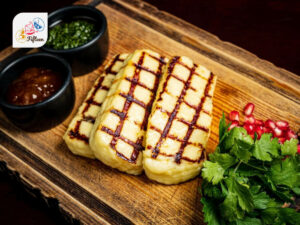
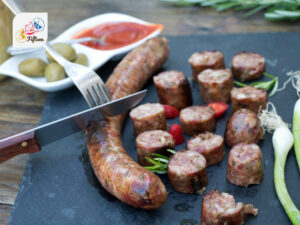







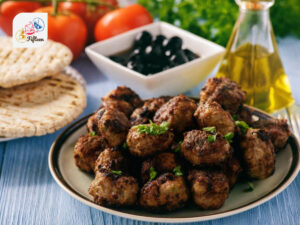
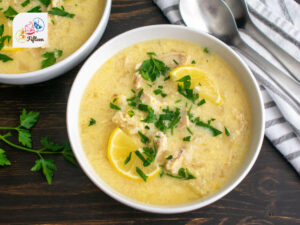
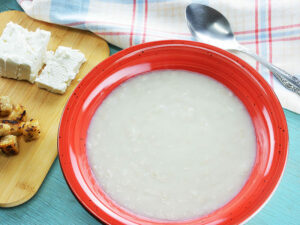
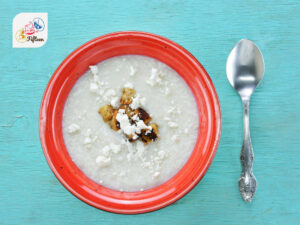
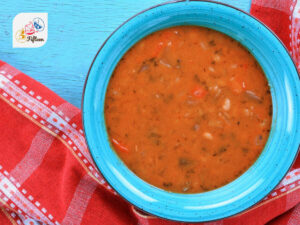
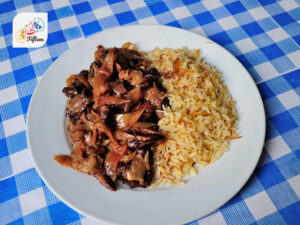
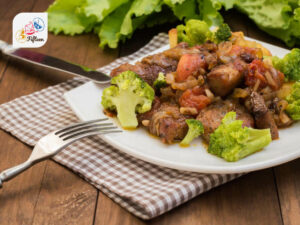
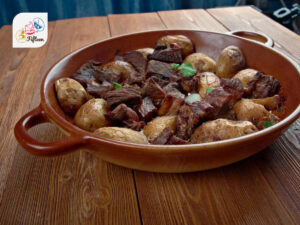
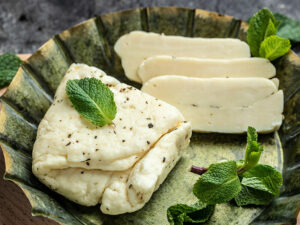
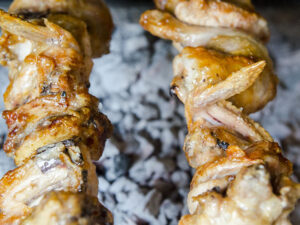
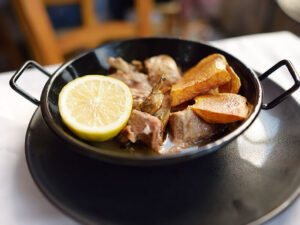
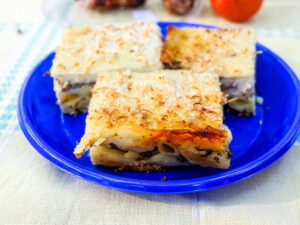
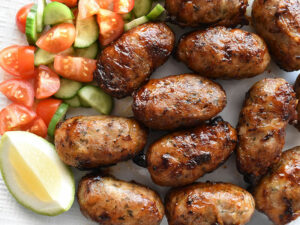
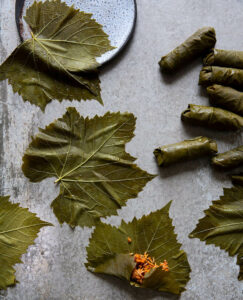
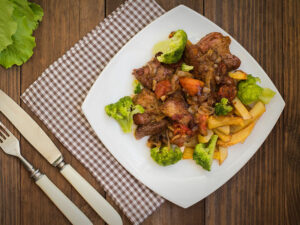

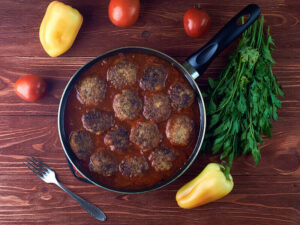
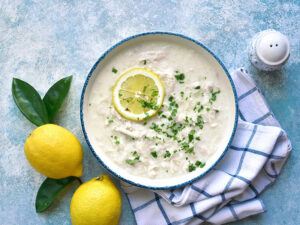


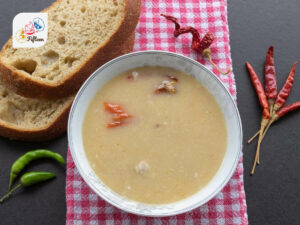
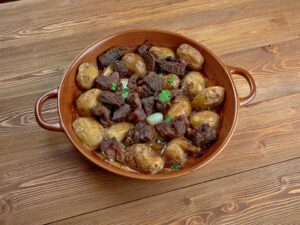

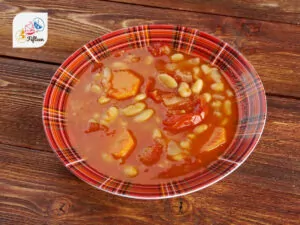
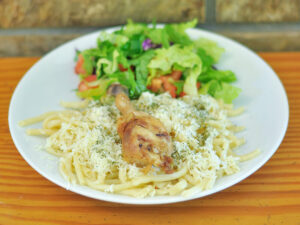
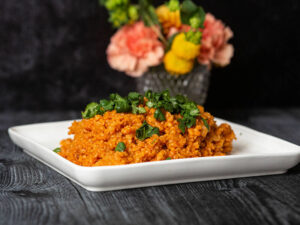
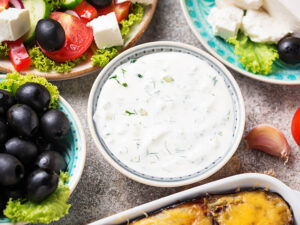


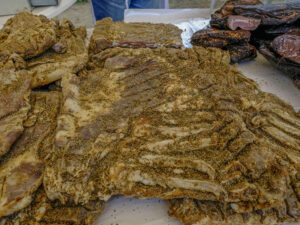
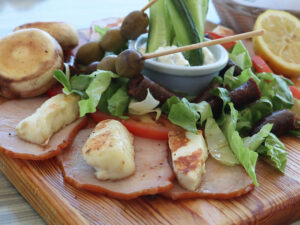
Jamie Scott
Editor in Chief, Senior Content Writer
Expertise
Home Cooking, Meal Planning, Recipe Development, Baking and Pastry, Food Editor, Cooking-video Maker, Western Food Evaluation Expert
Education
Le Cordon Bleu College of Culinary Arts
Local Community College, New York, NY
Jamie Scott is a skilled culinary expert and content creator specializing in Western cuisine. With over 15 years in the culinary field and formal training from Le Cordon Bleu, Paris, Jamie deeply understands how to blend nutrition with delicious flavors. His passion for cooking matches his commitment to making healthy eating accessible and enjoyable.
On Fifteen.net, Jamie brings a fresh perspective to classic dishes and beverages, offering readers insightful recipes, cooking tips, and a fresh view on meal planning that emphasizes taste, health, and simplicity.